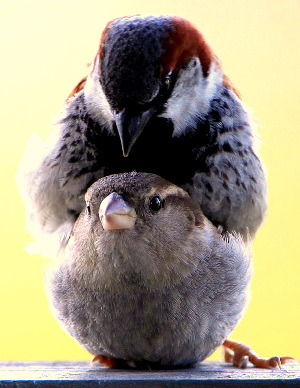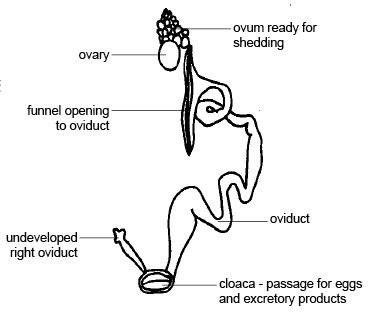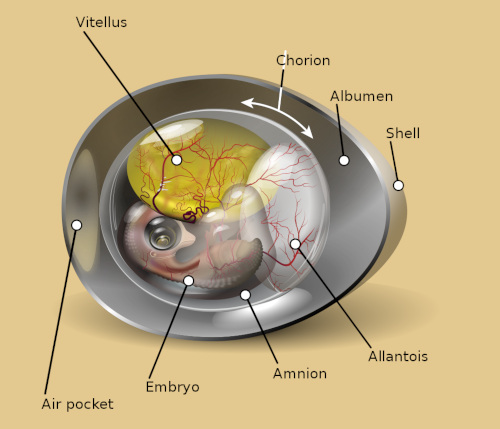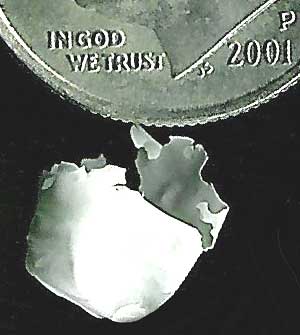 House Sparrows mating; image courtesy of "Nigel" in Vancouver, Canada & Wikimedia Commons
House Sparrows mating; image courtesy of "Nigel" in Vancouver, Canada & Wikimedia CommonsAccording to a 2013 National Geographic article, the males of only around 3 percent of all bird species have a penis. Ducks have them, and sometimes they're helical and longer than the duck's entire body. Besides ducks, geese, swans and large flightless birds like ostriches and emus have them. However, just about every other kind of bird, from eagles and penguins to albatrosses, gulls and hummingbirds, don't have penises. Chickens more or less have them, but they're just tiny nubs too short to penetrate anything.
In that case, what are the House Sparrows doing in the picture?
In typical bird-sex -- like what the House Sparrows are doing as members of the penisless 97% of species -- the male's semen is introduced into female's body by a process neatly referred to as the cloacal kiss. Both parties twist their tails to the side, turn back the feathers around the swollen lips of their cloacae (holes used both for pooping and sex), the cloacae's lips are pressed together, and sperm pass from the male into the female. Swifts and swallows can mate in midair.
 Female reproductive organs of a bird; image courtesy of Ruth Lawson, Otago Polytechnic, New Zealand, & Wikimedia Commons
Female reproductive organs of a bird; image courtesy of Ruth Lawson, Otago Polytechnic, New Zealand, & Wikimedia CommonsAfter mating, inside the female, sperm swim up a tube called the oviduct, at the end of which lies an ovum, inside which resides the female sex germ. If the ovum is mature, it's already equipped with yolk, the yellow part of the future egg. The sperm may now fertilize the ovum by penetrating it and uniting its male genetic material with that of the female. Fertilization doesn't necessarily take place soon after mating. Domestic chickens and turkeys can produce fertile eggs seventy days after copulation.
 Diagram of a chicken egg in its 9th day; image courtesy of "KDS4444" & Wikimedia Commons
Diagram of a chicken egg in its 9th day; image courtesy of "KDS4444" & Wikimedia CommonsAfter fertilization, the ovum with its yolk begins its own journey down the oviduct, a process lasting about 24 hours. During the first three or four hours, moving at about one tenth of an inch (2.3 mm) per minute, albumen, or "egg white," is added around the ovum and its yolk, or "vitellus," as labeled in the diagram. The yellow yolk will serve as food material for the developing chick; the white albumen will mainly keep the yolk from drying out, and will give the yolk physical support. Now the future egg slows to about 40 percent of its earlier speed, and membranes -- labeled "chorion" and "allantois" in the diagram -- are added around the yolk and egg white. Finally the shell is put in place, taking 19 to 20 hours. The shell is mostly composed of the mineral called calcium carbonate, which has the same chemical formula as limestone. No wonder egg shells are so hard and brittle!

Technically speaking, eggs are single cells, even though we normally think of cells as too small to see with our naked eyes. In fact, eggs are the largest cells known in the animal kingdom. They range in size from tiny ones produced by hummingbirds (0.006 oz, or 0.2 gram), to nearly twenty pounds (9 kg), laid by the Elephantbird of Madagascar, which is now extinct, but was known by primitive humans. At the right you can see half of an eggshell discarded by a Ruby-throated Hummingbird soon after a nestling had hatched. The coin above it is a 10-cent piece, the smallest US coin.